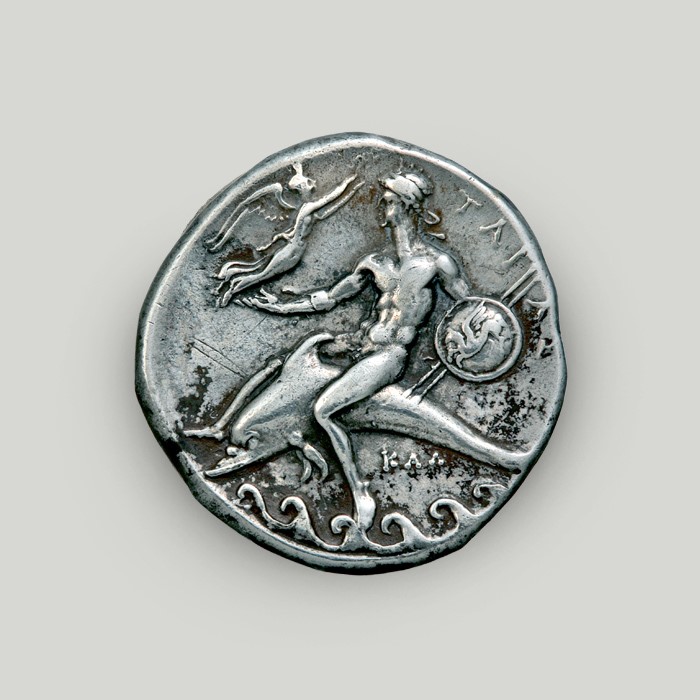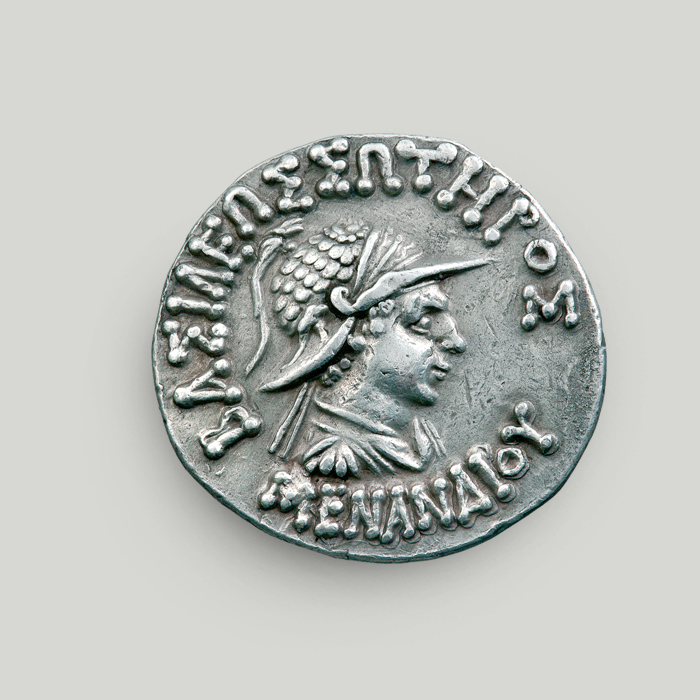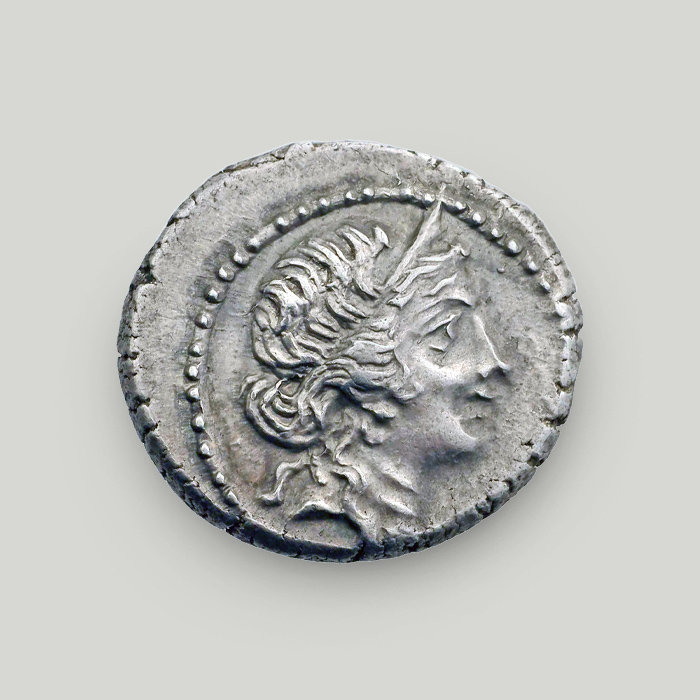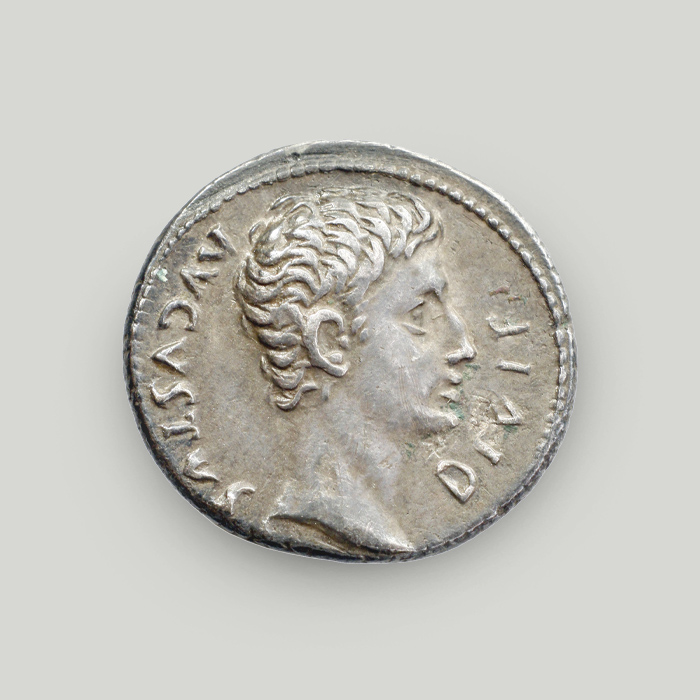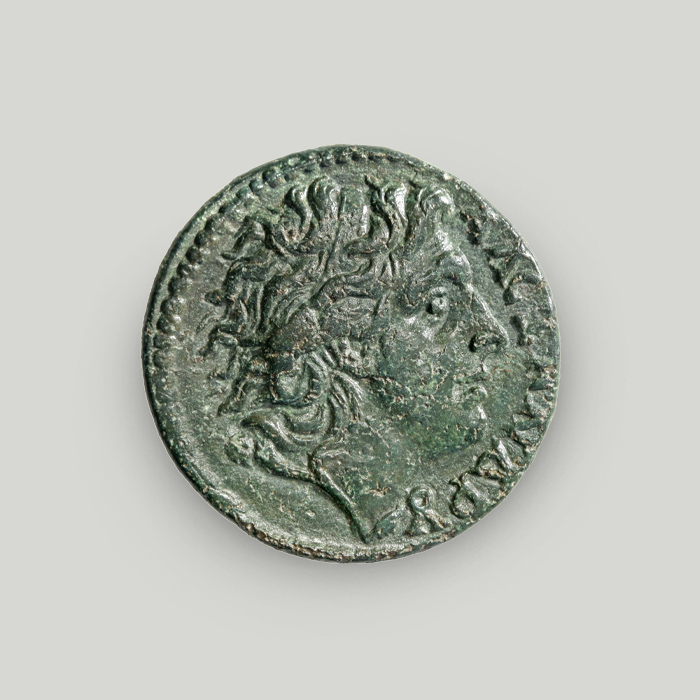Silver stater, Tarentum
Tarentum in Southern Italy was the only colony founded by Sparta. It came to be one of the most important Greek cities – a commercial hub with a prolific mint. For centuries, it was the gateway to the markets of the West. The type depicting a hero riding a dolphin became the city standard and is widely recognised in Greek art.
Obverse
Youth standing by his horse, while an attendant ties his chiton (tunic). The legend reads ΤΑΛ ΚΑΛ ΞΕ. These are the first letters of the moneyers’ names.
Reverse
Hero riding a dolphin swimming on the waves. He holds 2 spears and a shield depicting the mythical winged horse Pegasus. A flying Nike (Victory) crowns the hero. The legend on the right reads the local name ΤΑΡΑΣ (Taras). Beneath the dolphin, the legend reads ΚΑΛ: these are the first letters from the name of one of the moneyers.
The Partheniae and the Delphic oracle
During the First Messenian War, the Spartans had vowed not to return home unless they were victorious. However, 10 years into the war, the unmarried women left back requested that at least a few young men should return so that they could procreate, lest Sparta was deprived of its next generation.
The children born to those unmarried women were considered bastards and were called Partheniae (i.e. the sons of unmarried women). When the 20-year war ended, the Partheniae revolted, as the Spartans refused to grant them citizenship as promised at wartime. To resolve the matter, the city sought help from the Delphic oracle. According to the prophecy, the Partheniae had to leave Sparta and found a colony.
A gateway to the West
The Partheniae established their colony in 706 BCE. Taras (later Tarentum, present-day Taranto) was the only Spartan colony in the Italian Peninsula.
It was built at an enchanting location in Southern Italy, around the country’s largest natural port. It became one of the most important cities and, for centuries, it was a gateway to the markets of the West.
The Greek city is buried under the modern city of Taranto, and very few ruins have been recovered despite extensive archaeological research.
Growth and affluence
The city’s location and natural resources, with plenty of produce coming from the land and the sea, played a key role in its subsequent growth.
The affluence of the area, which reached its peak during the 4th century BCE, resulted in a lavish lifestyle. This affluence, as well as the city’s vibrant commercial activity, are reflected in Tarentum’s prolific production of coinage.
The hero astride the dolphin
The type of Tarentine coinage preserves a memory of the colonists’ adventures. The Partheniae were shipwrecked after sailing from Sparta. Poseidon sent a dolphin that carried Phalanthus safely to the shore.
Phalanthus was the oikistes, i.e. the leader of the colonising mission and future founder of Tarentum. Other sources hold that the city was founded by the local hero Taras, born to Poseidon and a nymph, and, therefore, he is the one depicted astride the dolphin.
This scene became the symbol of the city and was recognised in Greek art as “the hero on the dolphin”. The type remained standard for as long as coins were minted by the city.
Staters in antiquity
The word “stater” corresponds to an ancient coin denomination. Etymologically, it is derived from the Phoenician schequel, which denoted a coin weighed to comply with a specific standard.
The weight of a stater varied significantly by region, and according to the weight standard applied by the mint.
The coin in our publications
The silver stater of Tarentum is mentioned in the book The Europe of Greece: Colonies and Coins from the Alpha Bank Collection, edited by Dr Dimitra Tsangari. The publication presents the Second Greek Colonisation, and the history and ancient coins of 39 Greek colonies. The catalogue includes original photographs of the colonies, 53 ancient artefacts, as well as 93 ancient coins from the Alpha Bank Numismatic Collection.
Buy the publication The Europe of Greece: Colonies and Coins from the Alpha Bank Collection on the Alpha Bank e-shop.
The Alpha Bank Numismatic Collection is not open to the public.
Research visits to the Numismatic Collection can be organised upon request.
Contact us to book your visit.

